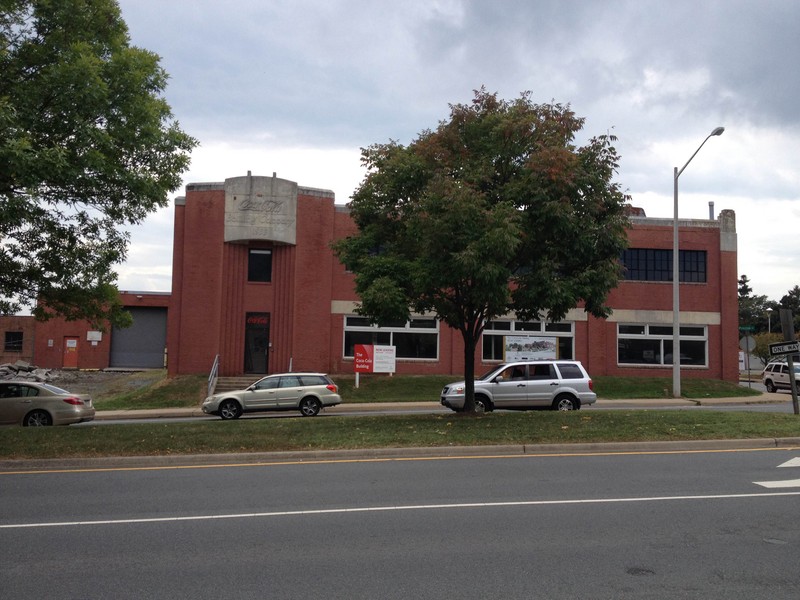Charlottesville Coca-Cola Bottling Plant
Introduction
Text-to-speech Audio
The Charlottesville Coca-Cola Bottling Plant, not to be confused with the older Coca-Cola Bottling Works at 134 Tenth Street NW, is a historic commercial and protected property. It is one of the few examples of Art Deco buildings in the city. The facility was originally built in 1939 and is quite similar in design to other Coca-Cola plants in Virginia. Today, it serves as retail space for several businesses.
Images
Exterior view of the Charlottesville Coca-Cola Bottling Plant. Image by Nickmorgan2 - Own work, CC BY-SA 3.0, https://commons.wikimedia.org/w/index.php?curid=35602274

Backstory and Context
Text-to-speech Audio
Charlottesville, Virginia is home to two Coca-Coca bottling works. The two-story brick facility on Preston Street is the younger of the pair, originally constructed in 1939 by Davis & Platt in a largely residential area. The Coke Building is Charlottesville's largest example of Art Deco Architecture. It is similar to other Coca-Cola plants in the country, such as the Coca-Cola Bottling Works located in Winchester, Virginia. Similar facilities also reportedly exist in
Frederick, Maryland; Silver Spring, Maryland; Romney, West Virginia; and Williamsport, Pennsylvania.
Designed by Washington, D.C. architect Doran Platt, the 1939 plans called for a two-story brick bottling plant with a reinforced concrete structure. A one-story wing extended southwards, and a detached one-story, 42-truck garage was located to the south of the building. During its use as a bottling plant and distribution center, the structure was expanded twice; a one-story bottle and crate storage warehouse was added on the east side of the garage in 1955 and, in 1981, a one-story L-shaped cinderblock warehouse was added to the plant.
The original design incorporated Coca-Cola's response to general public health concerns regarding sanitation following the passage of the Pure Food and Drug Act of 1906. Large windows bathed the interior with natural light and once allowed pedestrians to view the bottling process. The company had the windows bricked in during the 1980s, a result of a changing corporate attitude that discouraged revealing details of the warehouse operation to potential consumers. The windows have since been restored as part of a revitalization effort.
The most distinctive Art Deco elements of the structure are located on the building's exterior, as the interior was largely utilitarian in design. Of particular note are the architectural features on the main Preston Avenue elevation. The elevation consists of brick laid in four-course Flemish Stretcher Bond. Contrasting zones of white cast stone line the top of the entrance, the coping over the parapet, the stepped pilaster caps, and the spandrel zone between the first two floors. A white cast stone panel above the entrance reads "Coca-Coca Bottling Company 1939" in the iconic Coca-Cola Spencerian script.
Coca-Cola used the building as a bottling plant until 1973, and then as a distribution center until its closure in 2010. Riverbend Development acquired the property and has since begin renovating the 38,000 square foot plant, which now serves as retail and office space, and as a non-profit hub. The Coke Building was designated as a Virginia Historic Landmark in 2012 and added to the National Register of Historic Places in 2013.
Designed by Washington, D.C. architect Doran Platt, the 1939 plans called for a two-story brick bottling plant with a reinforced concrete structure. A one-story wing extended southwards, and a detached one-story, 42-truck garage was located to the south of the building. During its use as a bottling plant and distribution center, the structure was expanded twice; a one-story bottle and crate storage warehouse was added on the east side of the garage in 1955 and, in 1981, a one-story L-shaped cinderblock warehouse was added to the plant.
The original design incorporated Coca-Cola's response to general public health concerns regarding sanitation following the passage of the Pure Food and Drug Act of 1906. Large windows bathed the interior with natural light and once allowed pedestrians to view the bottling process. The company had the windows bricked in during the 1980s, a result of a changing corporate attitude that discouraged revealing details of the warehouse operation to potential consumers. The windows have since been restored as part of a revitalization effort.
The most distinctive Art Deco elements of the structure are located on the building's exterior, as the interior was largely utilitarian in design. Of particular note are the architectural features on the main Preston Avenue elevation. The elevation consists of brick laid in four-course Flemish Stretcher Bond. Contrasting zones of white cast stone line the top of the entrance, the coping over the parapet, the stepped pilaster caps, and the spandrel zone between the first two floors. A white cast stone panel above the entrance reads "Coca-Coca Bottling Company 1939" in the iconic Coca-Cola Spencerian script.
Coca-Cola used the building as a bottling plant until 1973, and then as a distribution center until its closure in 2010. Riverbend Development acquired the property and has since begin renovating the 38,000 square foot plant, which now serves as retail and office space, and as a non-profit hub. The Coke Building was designated as a Virginia Historic Landmark in 2012 and added to the National Register of Historic Places in 2013.
Sources
"Charlottesville Coca-Cola Bottling Works." Wikipedia, the Free Encyclopedia. Accessed December 27, 2016. https://en.wikipedia.org/wiki/Charlottesville_Coca-Cola_Bottling_Works.
"Coca-Cola Building." Cvillepedia - Charlottesville Tomorrow's Community Wiki. Accessed December 27, 2016. http://www.cvillepedia.org/mediawiki/index.php/Coca-Cola_Building.
"History — The Coke Building." The Coke Building. Accessed December 27, 2016. http://www.thecokebuilding.com/history.
"National Register of Historic Places Nomination Form: Charlottesville Coca-Cola Bottling Works." National Park Service. Last modified December 17, 2012. https://www.nps.gov/nr/feature/places/pdfs/13000045.pdf.
"Coca-Cola Building." Cvillepedia - Charlottesville Tomorrow's Community Wiki. Accessed December 27, 2016. http://www.cvillepedia.org/mediawiki/index.php/Coca-Cola_Building.
"History — The Coke Building." The Coke Building. Accessed December 27, 2016. http://www.thecokebuilding.com/history.
"National Register of Historic Places Nomination Form: Charlottesville Coca-Cola Bottling Works." National Park Service. Last modified December 17, 2012. https://www.nps.gov/nr/feature/places/pdfs/13000045.pdf.
